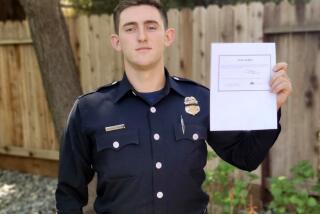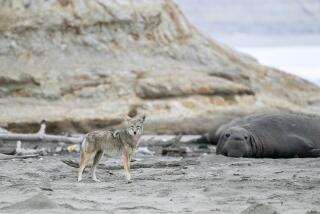No charges in drowning of Navy SEAL candidate
- Share via
The Navy said Monday it won’t file criminal charges in the drowning of Seaman James Derek Lovelace during SEAL training in Coronado.
The San Diego County medical examiner had ruled the 21-year-old sailor’s death on May 6, 2016, in a swim tank as a homicide, saying in an autopsy report that the “actions, or inactions, of the instructors and other individuals involved were excessive and directly contributed to the death.”
But Navy Cmdr. Liam Hulin, director of the Naval Special Warfare Basic Training Command, reviewed the findings of a Naval Criminal Investigative Service probe and determined that Lovelace’s drowning “was not the result of a crime and will not pursue criminal charges against any personnel in connection with the death,” according to a statement issued to the San Diego Union-Tribune.
“Our thoughts and prayers remain with the Lovelace family,” Hulin said in the statement. “No loss of life in training is an acceptable loss.”
A safety review of the incident that had been put on pause by the criminal investigation will now begin, according to the Navy.
Lovelace died during Combat Swimmer Orientation, a test that takes place in the first week of BUD/S training to assess a SEAL candidate’s swimming abilities. Students tread water and perform what the Navy describes as survival skills, including the removal of a swim mask, uniform and boots.
The county medical examiner’s autopsy report revealed that a SEAL instructor repeatedly dunked Lovelace and that the student’s drowning was exacerbated by an anomalous coronary artery, a heart condition that might have contributed to sudden cardiac death during the intense exercise. Although Lovelace appeared conscious when pulled out of the pool, witnesses said his face had turned purple, his lips blue.
Navy officials have long contended that the medical examiner’s homicide ruling meant only that Lovelace died “at the hands of another” and did not necessarily suggest a crime had been committed.
On Monday, they didn’t address the autopsy findings. They instead expressed a commitment to improving SEAL training.
“To honor those who have fallen in combat, we must provide the most realistic and operationally relevant training possible. To honor those who have fallen in training, we must effectively mitigate the risks of that training,” Capt. Jay Hennessey, commander of the Naval Special Warfare Training Center, said in the same statement that contained Hulin’s remarks.
Naval Special Warfare “training has been refined over more than 50 years, informed throughout by lessons learned in combat overseas as well as in training at home,” he added. “We learn not only from our successes, but also from operational and training failures, mistakes and accidents. While these tragic occasions are infrequent, they greatly impact our small close-knit force and magnify the responsibility we feel to our teammates who have paid the ultimate price.”
Lovelace was from Crestview, Fla. Navy officials said they briefed his father in Florida on Saturday about Hulin’s conclusions.
“We have maintained contact with the Lovelace family,” said Naval Special Warfare spokesman Capt. Jason Salata. “Our primary point of contact is Seaman Lovelace’s father. He is designated as his official next of kin. As a courtesy, the Navy has also reached out to Seaman Lovelace’s siblings and offered counseling and other services. As part of the prosecutorial review of this case, the father’s input was carefully considered.”
Lovelace’s father and his sister couldn’t be reached for comment Monday.
Salata said the criminal probe followed Pentagon protocols standard to any death that occurs during training. Led by the Navy Region Southwest’s chief trial counsel, a team of prosecutors with no ties to the SEALs reviewed the probe’s findings before they were forwarded to Naval Special Warfare’s commanders.
When asked by the Union-Tribune if any SEAL instructors would receive letters of reprimand or so-called counseling statements for their role in the incident, Salata wrote that no other action “is being taken on anyone in connection with the case.”
Salata also said the Navy intends to make the probe’s findings public once criminal investigators close their case.
Lovelace was embarking on a six-month odyssey to become a SEAL. The tryout process is notoriously difficult; only about a quarter of the candidates make it through without dropping out.
In the wake of his drowning, the Naval Special Warfare Basic Training Command halted the program to review and reinforce protocols for pre-training briefs, emergency action and in-water instruction procedures, Navy officials said. The Navy added instruction about the signs and symptoms of water training injuries and lifesaving procedures.
Today, two additional safety observers are in the water during the class, plus two safety swimmers at the water’s edge to quickly remove struggling students. The instructor-student ratio now is one to seven; it was one to 10 before Lovelace’s death.
Last year, 75 students could be in the water at one time. Now, no more than 49 can be in the pool simultaneously.
In the last three decades, Lovelace was at least the fifth SEAL candidate to die during training.
In 1988, John Joseph Tomlinson, 22, from Altoona, Pa., died of hypothermia near the end of a 5½-mile ocean swim off Coronado in the 17th week of the 25-week course.
Ten years later, Gordon Racine Jr., 25, of Houston died during a pool exercise in his first month of training.
In 2001, Lt. John Anthony Skop Jr., 29, of Buffalo, N.Y., died during a “Hell Week” swim.
Three years later, Boatswain Mate 1st Class Rob Vetter, 30, died at a Coronado hospital days after he collapsed during a conditioning run in the second week of the program.
Prine writes for the San Diego Union-Tribune.
ALSO
Wrongful-convictions database moves to UC Irvine
Campaign mailer with photoshopped images draws accusations in L.A. City Council race for Valley seat
More to Read
Sign up for Essential California
The most important California stories and recommendations in your inbox every morning.
You may occasionally receive promotional content from the Los Angeles Times.













